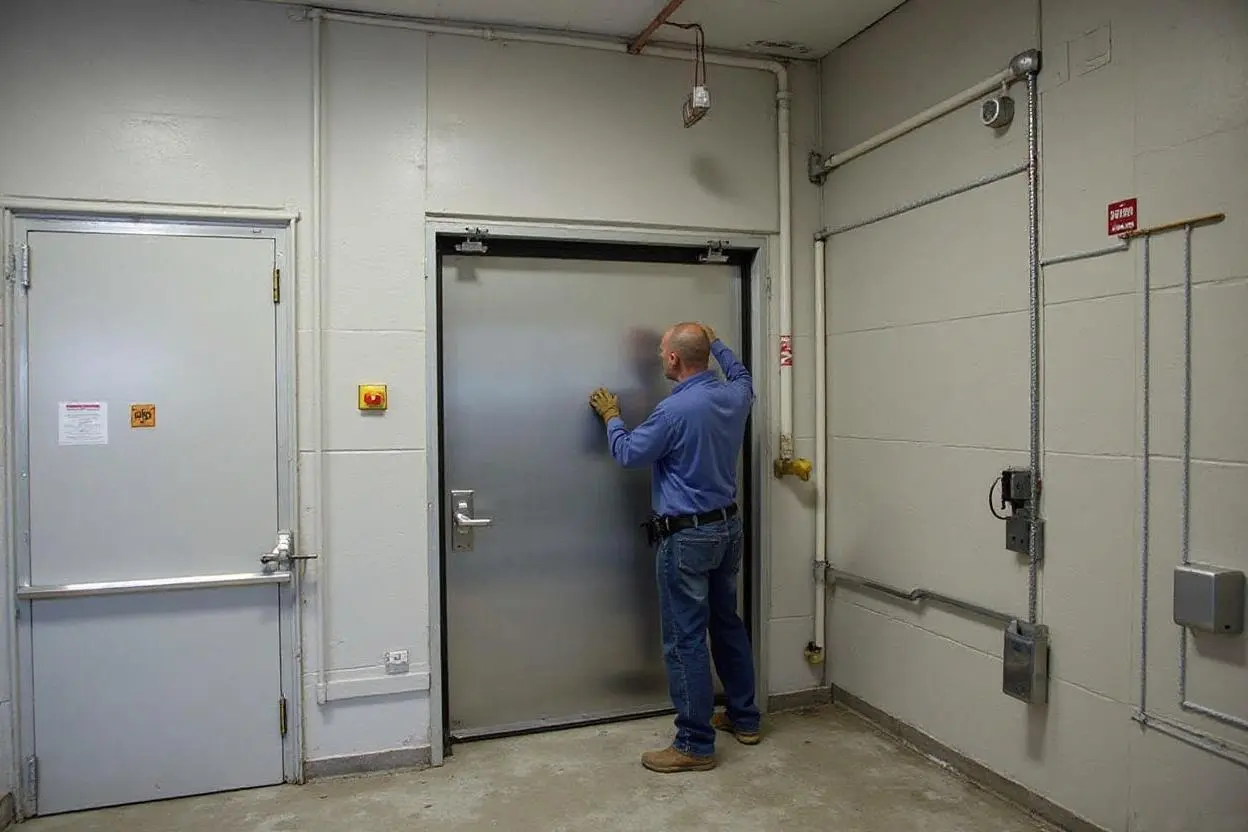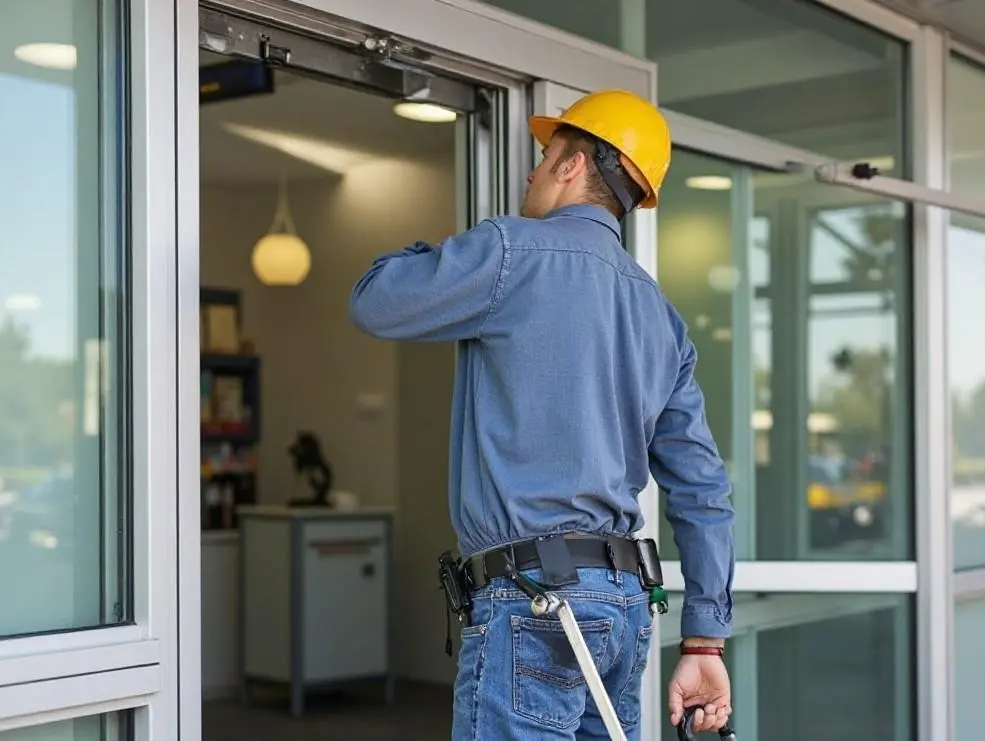Should You Repair or Replace Your Old Automatic Sliding Doors?
Automatic sliding doors work hard in Buffalo. Lake-effect snow, salt, wind gusts off the river, and heavy foot traffic from morning through game days all add up. When doors slow down, chatter, or stop responding, building owners face a practical choice: repair the system or replace it. This guide explains how to make a smart call that protects safety, keeps customers moving, and controls cost. It speaks to malls in Cheektowaga, clinics on Elmwood, offices downtown, and grocery stores in North Buffalo that need clear answers and fast service.
What fails first on older sliding doors
Most automatic sliding doors fail in predictable ways. Sensors drift out of alignment or get coated in salt and slush. Rollers flatten. Belts stretch. Tracks clog with debris. Control boards suffer from moisture and voltage spikes. Safety edges and presence sensors age out and stop meeting current ANSI A156.10 standards. Doors can still move, but they hesitate, stick, or close too firmly. Staff start propping them open, which hurts energy use and creates risk.
In Buffalo’s winters, ice buildup and rapid temperature swings stress components twice a day. A door that runs fine at 2 pm can drag by 6 pm as temperatures fall. That pattern points to worn rollers or a tired belt rather than a bad operator — a common repair, not an immediate replacement.
Quick ways to triage before calling
A brief visual check can save time. Clear the threshold, wipe the sensors with a soft cloth, and power-cycle the operator if it has a local switch. If the door returns to normal for a few hours then slips again, expect a wear item at end of life. If the door fails hard or behaves erratically, the issue may be electrical or software related. In either case, schedule a visit. For automatic sliding doors repair Buffalo property managers often want same-day stabilization, then a plan. That is reasonable and achievable in most cases.
Repair is the right move when
- The operator is under 10 to 12 years old and parts are available.
- The failure is on wear items such as rollers, belts, end caps, tracks, or basic sensors.
- The door frame is square, glass is intact, and the header is dry.
- The unit meets or can be brought to current ANSI safety standards with a sensor upgrade.
- Downtime must be minimal and the traffic level is moderate.
On recent NABCO, Horton, ASSA ABLOY/Record, and Stanley units, replacing rollers and belts often restores smooth operation for two to five years. A sensor refresh can tighten safety and reduce nuisance stops at busy entrances like those on Delaware Avenue. These repairs are comparatively fast and cost-effective, and they postpone capital expense without sacrificing safety.
Replacement makes sense when
If the operator is past 15 years, parts are scarce, or the header is corroded from roof leaks, repairs turn into a cycle. Frequent callouts can exceed the price of a new system within a year. Systems installed before major sensor standard updates can also be risky in high-traffic settings such as hospital lobbies near the Buffalo Niagara Medical Campus.
Replacement is the cleaner choice when the door struggles daily, cannot hold adjustments, or fails safety compliance even after sensor work. A new operator runs quieter, uses less power, and brings up-to-date monitoring and self-check features. In cold zones like South Buffalo, newer drives that modulate torque handle icy thresholds better and reduce bounce-backs.
Cost ranges Buffalo owners actually see
Every site is different, but the numbers below reflect real projects across Erie County:
- Common repairs: rollers and belt on a standard two-panel slider often land in the low four figures, including labor and setup. Add a sensor set and it becomes mid four figures.
- Mid-scope repairs: track section replacement, control board swap, or water-intrusion remediation can push into the higher four figures.
- Full replacement: modern operator with safety sensors and programming typically runs in the low to mid five figures, depending on width, glass, and traffic class.
If a site logs three or more service calls in six months for the same door, replacement usually wins on total cost within 12 to 24 months.
Safety and compliance in Western New York
Doors must meet ANSI A156.10 with proper approach, presence, and threshold protection. For health care and public facilities, the standard is non-negotiable. Snowbanks and salt spray confuse older sensors; modern radar and infrared arrays filter clutter better and maintain detection on dark clothing and winter coats. If a door is marginal on safety tests during a Buffalo winter, it is not a good candidate for patchwork fixes. Upgrading sensors or replacing the operator protects patrons and reduces liability.
Annual inspections are wise. A-24 Hour Door National Inc. performs documented safety checks, impact force measurements, and signage verification. These records help with insurance and keep the site compliant ahead of surprise audits.
Energy and comfort
Poorly running sliders leak heat. A door that fails to close fully or cycles unnecessarily can add thousands per year in heating costs downtown where the wind funnels along Main Street. Newer operators close faster, seal better, and integrate with vestibule logic. Upgrading weather sweeps and adding tighter closing profiles during a repair can deliver quick savings, especially for grocery and retail entries with constant traffic. For locations near the lake, corrosion-resistant components and proper drip management in the header are essential.
What a proper repair visit should include
A thorough service call starts with a site interview and a quick review of traffic patterns. The technician runs the door through all modes, checks error logs when available, and inspects rollers, belts, track, motor, controller, gearbox, and sensors. The team verifies signage, tests approach and presence zones with a calibrated target, measures closing force, and documents findings.
In Buffalo, experienced techs also look for roof and soffit leaks above the header, salt stains in the track, and heave in concrete thresholds. They reset limits, lubricate where appropriate, and clean sensors. The invoice should note parts replaced, measurements taken, and any safety gaps with clear remedies.

Telltale signs it is time to replace
Several issues reliably predict replacement within the year:
- Water damage inside the header or a swollen, rusted frame.
- Control board obsolescence with no compatible sensors available.
- Frequent false reversals that persist after alignment.
- Worn or cracked door stiles that flex under load.
- Doors older than 15 years with multiple major components already replaced.
If two or more of these appear, owners in Amherst or Tonawanda often save time and money by scheduling a new operator rather than chasing intermittent faults.
How weather shapes the decision locally
Buffalo’s freeze-thaw cycles punish bearings and rollers. Snow tracked into the sill creates drag that burns belts. Storefronts facing prevailing winds see more forced-air inflow, which amplifies sensor false triggers. Sites near salted streets experience accelerated corrosion in the header and track. For those entrances, stainless fasteners, sealed bearings, and upgraded presence sensors provide better results. A professional who works here factors these conditions into both repair choices and replacement specs.
Planning upgrades without disrupting business
Retail and medical sites cannot afford long closures. A-24 Hour Door National Inc. stages parts and preps operators in the shop to compress on-site work. Repairs that keep the opening safe and functional happen during off-hours, often early morning. Full replacements can be phased: one leaf at a time, temporary barriers, or a planned Sunday install. For multi-tenant buildings downtown, the team coordinates with security and HVAC to keep access and airflow managed through the day.
Make a decision with clear math
Owners should compare three numbers: the cost to repair now, the expected months of reliable service that repair buys, and the installed price of a new system. If a repair at a modest cost yields two to three years of dependable service, it is a good move. If the repair cost crosses one-third of a new operator and reliability is uncertain, replacement usually wins. Fold in energy loss from poor sealing and the risk of unplanned downtime during a snowstorm or event night. That is where many Buffalo sites tip toward a new unit.

Why local experience matters
Automatic doors behave differently on Hertel Avenue than they do in Phoenix. Salt fog, drifting snow, and wide temperature swings are normal here. Local technicians carry parts that match those conditions and know A-24 Hour Door National Inc: automatic sliding doors repair Buffalo which models last on high-traffic streets, which sensors ignore blowing snow, and which rollers keep their shape in deep cold. That judgment saves callbacks and protects customer flow on busy weekends.
Ready for service in Buffalo, NY
For automatic sliding doors repair Buffalo businesses trust, A-24 Hour Door National Inc. is on call. The team services downtown, Allentown, Elmwood Village, North Buffalo, South Buffalo, Cheektowaga, Amherst, Tonawanda, Lackawanna, and nearby suburbs. Whether the door needs a quick belt and roller job, a sensor safety upgrade, or a full operator replacement, the company provides clear diagnostics, upfront pricing, and fast turnaround.
Describe the door’s behavior, brand if known, and the building type. Share if issues worsen in cold evenings or after snow. That detail speeds the fix. Call to schedule a same-day assessment or book an after-hours visit to keep traffic moving without disruption.
A-24 Hour Door National Inc provides commercial and residential door repair in Buffalo, NY. Our technicians service and replace a wide range of entry systems, including automatic business doors, hollow metal frames, storefront entrances, fire-rated steel and wood doors, and both sectional and rolling steel garage doors. We’re available 24/7, including holidays, to deliver emergency repairs and keep your property secure. Our service trucks arrive fully stocked with hardware, tools, and replacement parts to minimize downtime and restore safe, reliable access. Whether you need a new door installed or fast repair to get your business back up and running, our team is ready to help. A-24 Hour Door National Inc
344 Sycamore St Phone: (716) 894-2000 Website: https://a24hour.biz/buffalo
Instagram: @a24hourdoor
Buffalo,
NY
14204,
USA
Facebook: 24 Hour Door
Yelp: A-24 Hour Door National (Buffalo)
X (Twitter): @a24hrdoor